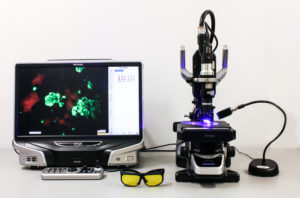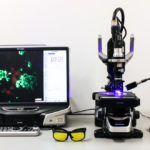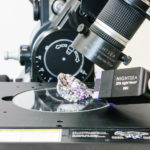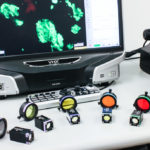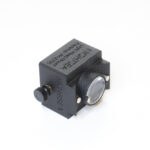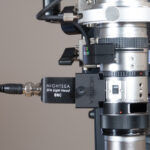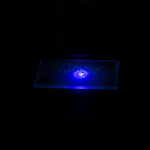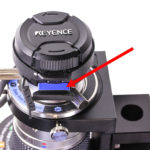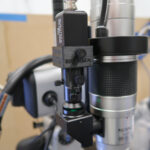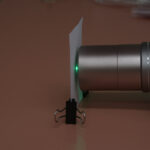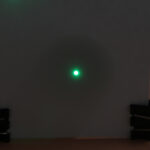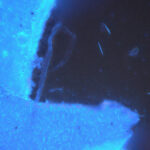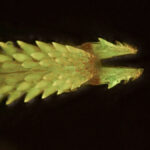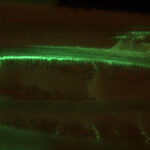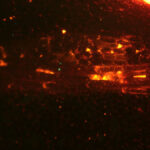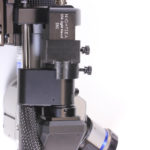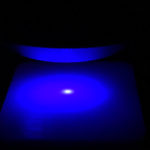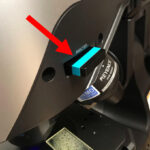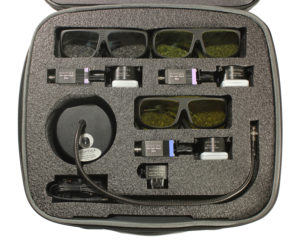Fluorescence Adapter for Keyence VHX Series Digital Microscopes
The NIGHTSEA Model SFA Fluorescence Adapter system adds a versatile fluorescence imaging capability to the Keyence VHX series of digital microscopes. A growing number of Keyence owners are using the system successfully for a variety of applications. To see examples of images made with Keyence systems visit our Keyence image gallery.
We also offer solutions for inspecting photoresist with the Keyence VHX series. These options provide illumination that is free of the UV and blue light that can expose the photoresist. We have solutions for a number of the most popular Keyence lenses.
Fluorescence solutions for most Keyence lenses
Our adaptations to the Keyence system are concerned with the lens, not the microscope model (VHX-5000, -6000, -7000 etc.). We offer variants of our fluorescence adapter system that work with the most commonly used Keyence lenses – the VH-Z00, -Z20, -Z50, -Z100, -Z500, -ZST, and with two of the lenses incorporated in the VHX-7100 Fully Integrated (FI) head (VHX-E20 and -E100). Our system is not recommended for use with the higher magnification lenses in the FI head.
The key elements of any fluorescence system are:
- a light source that produces sufficient energy in the appropriate wavelength range to excite fluorescence in the sample of interest;
- a barrier filter in the viewing path that blocks reflected excitation light while transmitting the fluorescence emitted by the sample.
NIGHTSEA implements these for the Keyence system with:
- high intensity LED light sources available in five excitation wavelength ranges (see list further down this page);
- emission barrier filters that can be easily added to the Keyence lenses.
The components of a NIGHTSEA system that adds a single excitation/emission wavelength combination on a Keyence microscope are:
- Flexible gooseneck lamp base with LED drive circuit and intensity control;
- Universal power supply (120/240VAC, 50/60Hz) with international plug set
- Excitation light source
- Emission barrier filter
- Barrier filter glasses for fluorescence viewing and eye safety
- Padded carrying case
Additional wavelength sets are implemented by adding a matched set (light plus filter set) consisting of a light source, barrier filter, and filter glasses.
Link – Imaging tips for Keyence microscopes with the NIGHTSEA adapter
Lens-specific solutions
The Keyence lens you are using (not the microscope model) determines how the NIGHTSEA light source and barrier filter will be added to the system. The light source will either placed to the side of the microscope stage or mounted over the Keyence light source input port. The barrier filter will either be slipped over the bottom of the lens or inserted in the Analyzer slot. The options are summarized in the table below.
| Excitation Source | Barrier Filter | |||
| LENS | Mounted | Side | Inserted | Below |
| FI Head – E20 or E100 | x | x | ||
| VH-Z500 | x | x | ||
| VH-Z100, -Z50 | x | x | x | |
| VH-ZST – 200-2000x | x | x | ||
| VH-ZST – 20-200x | x | x | ||
| VH-Z00, -Z20 | x | x | ||
Jump to a lens:
(Click any image for larger view)
- Light source – placed to the side of the microscope stage
- Barrier filter – slips over the bottom of the lens and attaches with thumbscrews
- NIGHTSEA light source positioned to the side of the microscope stage
- Z00 and Z20 lenses – the barrier filter slips over the bottom of the lens.
- Image shows the various light sources and corresponding barrier filters
- Light source – mounts over the Keyence light source input port (preferred) or placed to the side of the microscope stage
- Barrier filter – inserts in the Analyzer slot at the top of the lens
- NIGHTSEA LHM-Z100 light head mount
- VH-Z100 light input port with NIGHTSEA adapter and light head
- Z100 sample illumination with light directed through the lens
- Z100, Z500, and ZST lenses – the barrier filter inserts in the Analyzer slot at the top of the lens
- Light source – mounts over the Keyence light source input port
- Barrier filter – inserts in the Analyzer slot at the top of the lens
- VH-Z500 fiber optic port with NIGHTSEA adapter and light head
- Side view, VH-Z500 and focused illumination spot
- Bottom view, VH-Z500 illumination spot on a piece of paper
- Z100, Z500, and ZST lenses – the barrier filter inserts in the Analyzer slot at the top of the lens
- Z500, conformal coating failure, UV excitation, 500x
- Natural fluorescence of the business end of a tick, RB excitation, 500x Keyence VH-Z500 lens
- Z500, fluorescent penetrant on a semiconductor cross section for failure analysis, RB excitation, 1000x
- Z500, red fluorescent powder to show pores in a sample, RB excitation, 500x
- 20-200 lens
- Light source – placed to the side of the microscope stage
- Barrier filter – inserts in the Analyzer slot at the top of the lens
- 200-2000 lens
- Light source – mounts over the Keyence fiber optic input port (except for UV)
- Barrier filter – inserts in the Analyzer slot at the top of the lens
**NOTE – The Ultraviolet (UV) light source does NOT work well when mounted over the Keyence fiber input at either high or low magnification. Consider our Violet (VI) light source as an alternative for many applications.
- Keyence VH-ZST fiber optic port with NIGHTSEA adapter and light head
- NIGHTSEA focus spot with Keyence VH-ZST lens at high magnification
- Z100, Z500, and ZST lenses – the barrier filter inserts in the Analyzer slot at the top of the lens
VHX-7100 Fully Integrated (FI) Head
- VHX-E20 and -E100
- Light source – placed to the side of the microscope stage
- Barrier filter – inserts in the Analyzer slot at the right side of the FI head
- VHX-E500 and -E2500
- Use with these lenses is likely not practical due to short working distance
Wavelength sets
There are five excitation/emission wavelength combinations available for the system.
| Color | Designation | Excitation | Emission |
| Ultraviolet | UV | 360 – 380nm | 415nm longpass |
| Violet | VI | 400 – 415nm | 450nm longpass |
| Royal Blue | RB | 440 – 460nm | 500nm longpass |
| Cyan | CY | 490 – 515nm | 550nm longpass |
| Green | GR | 510 – 540nm | 600nm longpass |
Comprehensive solution kit
You can order individual wavelength sets, but we have configured Keyence fluorescence adapter kits that include the three most useful excitation wavelengths for varied industry applications, and that are suited to various combinations of the supported Keyence lenses. The kit price is significantly less than purchasing the items separately.
Each Industry Kit includes the following items, or a subset that is suited to the particular Keyence lenses you want to outfit:
- Three excitation light heads – Ultraviolet (UV), Violet (VI), and Royal Blue (RB)
- This recommendation is based on our experience with varied applications. Read the explanation below.
- Three barrier filters
- Matching barrier filter glasses for each excitation wavelength
- Accessory hardware for mounting the NIGHTSEA light head to the lens light input port
- enhanced performance at high magnification – available only for the VH-100, -500, and -ZST
- Gooseneck lamp base with dimming control
- Universal power supply – 120/240VAC, 50/60Hz, with international plug set
- Packing/carrying case with custom-cut foam
The part numbers for the 3-wavelength configuration depends on the Keyence lenses you want to work with:
- SFA-KZB-IND – supports the VH-Z00, -Z20
- SFA-KZ100-IND – supports the VH-Z100, -Z50
- SFA-KZ500-IND – supports the VH-Z500
- SFA-KZST-IND – supports the VH-ZST
- SFA-KFI-IND – supports the VHX-E20 and -E100 lenses of the Fully Integrated (FI) head
We can customize other configurations as needed, and you can also select additional wavelength sets from the list above that may be of use for other applications.
How to order
Order from the Electron Microscopy Sciences (EMS) web site.
For technical questions – contact NIGHTSEA
Do you need a quotation? Use the Quote Request Form.
Why we recommend a set of three excitation wavelengths for industry needs
We have found that the combination of the Ultraviolet, Violet, and Royal Blue excitation/emission sets addresses a wide variety of industrial imaging challenges. The most common misconception we encounter is that fluorescence is uniquely associated with ultraviolet (UV) light and many customers immediately ask for that wavelength. However we have found in several cases – even some in which UV was specifically recommended by a dye manufacturer – that either Violet or Royal Blue provided superior performance. For example:
- A prospective customer wanted to image concrete thin sections impregnated with fluorescent dye. The dye supplier recommended UV, and it is true that UV will make the dye fluoresce nicely. We found that our Royal Blue excitation produced significantly brighter fluorescence.
- Similar to above, except that a fluorescence epoxy had been used to highlight surface cracks in a test sample. Royal Blue excitation yielded brighter fluorescence.
- A prospective customer sent us a sample of material that was known to fluoresce under UV. The goal was to see the distribution of non-fluorescent particles in a fluorescent matrix. While both UV and Royal Blue excited fluorescence in the sample, the best imaging contrast was achieved with Violet excitation.
Acquiring the three-color system will provide the highest chance of success and will equip you with a versatile toolkit to address new fluorescence imaging challenges as they arise. Contact NIGHTSEA If you would like to discuss your application further.
Performance expectations
The microscopes in the Keyence VHX series were not designed for fluorescence. That said, the NIGHTSEA adapter system adds a fluorescence capability that is proving to be valuable for a growing number of users. Several companies have purchased multiple adapters so that they could replicate the performance across multiple microscopes. In at least one case the customer only purchased their Keyence system because of the added NIGHTSEA fluorescence capability that enabled a critical analysis function for them.
There is a direct correlation between the fluorescence intensity of the sample and the imaging magnification that can be achieved. With some of our solutions – for the -Z00, -Z20, and the FI head – the excitation light from our freestanding source is directed in from the side. It is not focused onto the target area by the Keyence optics, with the result that the greater the magnification (the smaller the area you are looking at), the less of the light emitted by the fluorescence there is to collect. Fortunately many industrial applications make use of highly fluorescent dyes, and imaging at 500 – 800x has been achieved. With other lenses – the -Z50, -Z100, -Z500, and -ZST – the excitation light source can be mounted over the Keyence light source fiber optic input port, resulting in a brighter spot on the subject.
We have a growing body of experience with a number of fluorescence applications with the Keyence VHX series digital microscopes and associated lenses, as shown in the image gallery. This includes several biological applications, including maize endosperm stained with Sytox Green, natural chlorophyll fluorescence, and mosquito midguts immunostained with a fluorescent antibody.

